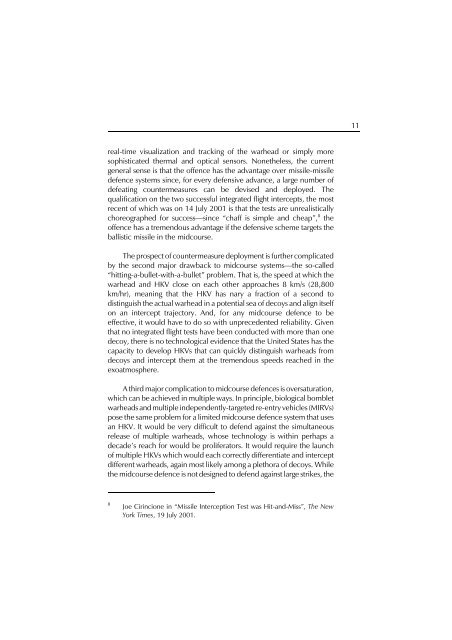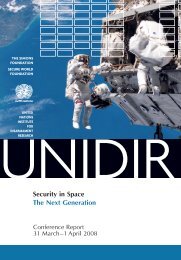Missile Defence, Deterrence and Arms Control - UNIDIR
Missile Defence, Deterrence and Arms Control - UNIDIR
Missile Defence, Deterrence and Arms Control - UNIDIR
Create successful ePaper yourself
Turn your PDF publications into a flip-book with our unique Google optimized e-Paper software.
RESPONSE<br />
To address the threat of emerging hostile ballistic missile threats, the<br />
United States takes a three-pronged approach: diplomacy, deterrence<br />
<strong>and</strong> defence. The first element, diplomacy, centres on arms control<br />
regimes designed to prevent the spread of missile <strong>and</strong> WMD technology.<br />
In practice though, for the United States this often means utilizing its<br />
diplomatic <strong>and</strong> economic leverage to dissuade States like the DPRK from<br />
pursuing potentially menacing capabilities. The 1994 Agreed Framework<br />
represents what some in Washington consider an example of a successful<br />
diplomatic effort to stymie weapons of mass destruction capabilities.<br />
High-level exchanges, engagement, <strong>and</strong> integrating a given State into<br />
accepted international norms of conduct are Washington’s primary<br />
diplomatic tools used to prevent the proliferation of ballistic missile<br />
capabilities.<br />
If diplomacy fails, Washington can rely on its formidable military<br />
means to prevent <strong>and</strong> deter States from threatening the United States or<br />
its interests. One possible option, almost exercised in 1994 against the<br />
DPRK, is strategic air strikes against key WMD or ballistic missile facilities<br />
as a means of preventive defence. While this response is risky, it can<br />
largely stymie a State’s ability to develop threatening capabilities—Israel’s<br />
strike against Iraq’s Osirak nuclear reactor in 1981 is believed to have set<br />
back Iraq’s nuclear programme by a number of years. In the event that<br />
a State is nevertheless able to acquire significant WMD <strong>and</strong> ballistic<br />
missile capabilities, the United States counts on its powerful conventional<br />
<strong>and</strong> nuclear forces as a deterrent. The threat of overwhelming retaliation<br />
in the event of a strike against United States, its allies or interests aims to<br />
deter a State from using ballistic missiles <strong>and</strong> WMDs. This policy of<br />
deterrence is quite credible both from a capability <strong>and</strong> resolve point of<br />
view.<br />
Nevertheless, to hedge against the possibility of deterrence failure,<br />
the United States is intent on pursuing a third response to emerging<br />
ballistic missile threats, <strong>and</strong> against accidental <strong>and</strong> unauthorized<br />
launches, namely the development of ballistic missile defences (BMD).<br />
The United States desires an added layer of security against emerging<br />
ballistic missile threats in the unlikely event that deterrence fails to<br />
3








